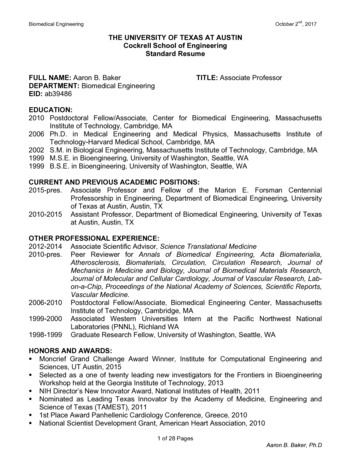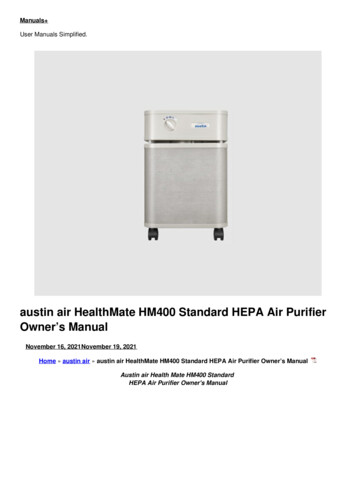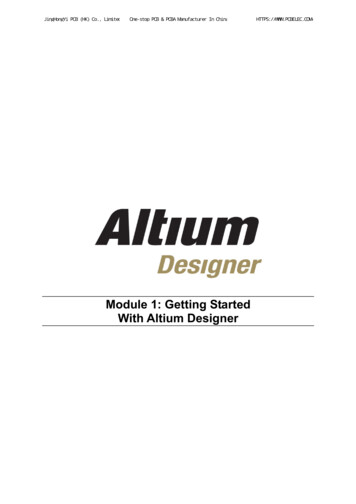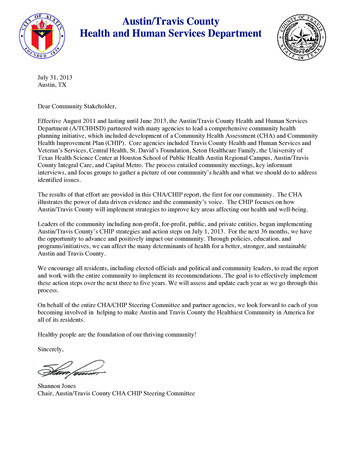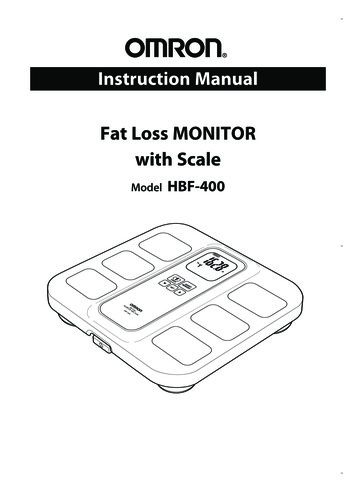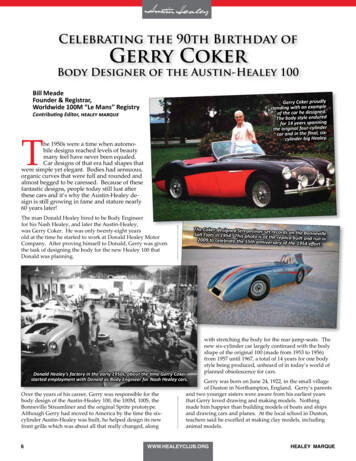
Transcription
Celebrating the 90th Birthday ofGerry CokerBody Designer of the Austin-Healey 100Bill MeadeFounder & Registrar,Worldwide 100M “Le Mans” RegistryGerry Coker proudlystanding with an exampleof the car he designed.The body style enduredfor 14 years spanningthe original four-cylindercar and in the final, sixcylinder big Healey.Contributing Editor, The 1950s were a time when automobile designs reached levels of beautymany feel have never been equaled.Car designs of that era had shapes thatwere simple yet elegant. Bodies had sensuous,organic curves that were full and rounded andalmost begged to be caressed. Because of thesefantastic designs, people today still lust afterthese cars and it’s why the Austin-Healey design is still growing in fame and stature nearly60 years later!The man Donald Healey hired to be Body Engineerfor his Nash Healey, and later the Austin-Healey,was Gerry Coker. He was only twenty-eight yearsold at the time he started to work at Donald Healey MotorCompany. After proving himself to Donald, Gerry was giventhe task of designing the body for the new Healey 100 thatDonald was planning.The Coker-designed Streamliner setrecords on the BonnevilleSalt Flats in 1954. This photo is of the2009 to celebrate the 55th annivers replica built and run inary of the 1954 effort.Donald Healey’s factory in the early 1950s, about the time Gerry Cokerstarted employment with Donald as Body Engineer for Nash Healey cars.Over the years of his career, Gerry was responsible for thebody design of the Austin-Healey 100, the 100M, 100S, theBonneville Streamliner and the original Sprite prototype.Although Gerry had moved to America by the time the sixcylinder Austin-Healey was built, he helped design its newfront grille which was about all that really changed, along6with stretching the body for the rear jump-seats. Thenew six-cylinder car largely continued with the bodyshape of the original 100 (made from 1953 to 1956)from 1957 until 1967, a total of 14 years for one bodystyle being produced, unheard of in today’s world ofplanned obsolescence for cars.Gerry was born on June 24, 1922, in the small villageof Duston in Northampton, England. Gerry’s parentsand two younger sisters were aware from his earliest yearsthat Gerry loved drawing and making models. Nothingmade him happier than building models of boats and shipsand drawing cars and planes. At the local school in Duston,teachers said he excelled at making clay models, includinganimal models.WWW.HEALEYCLUB.ORGHEALEY MARQUE
One of Gerry’s earliestmemories was at the age ofsix when he was allowedby his father to sit in thedriver’s seat of a huge redcar on display at Mulliners,a major local garage. Thecar turned out to be thefamous Sunbeam racerdriven on Daytona Beachby Sir Henry Seagrave,breaking the world landspeed record at 203 MPH.Who knew that one day thissmall boy would designanother famous land-speedrecord-breaker!Gerry’s father was employedat Mulliners as assistantmanager for the largegarage. At age 14, Gerry wasgiven his first job at CedosEngineering by the ownerwhose Hudson Terraplanewas serviced by Gerry’s fatherand where Gerry learnedmachine tool operation.firsthe purchased in 1948. He bought thisGerry’s 14-year-old 1934 Austin 7 thatk and also courted Marion in this car.car to travel to London for worIn 1939 at age 16, Gerry joined the Humber Motor Companyas an apprentice design draughtsman. This was to be for afive-year period which also included continuing education forGerry at Coventry Technical College in engineering science.This apprenticeship covered everything relative to the designand manufacture of the automobile.Unfortunately, while in this job, World War II broke out.Because Gerry was already working in the factory thatwould become responsible for design and production ofarmy vehicles, this became an authorized alternative for himto military service. Gerry was also a volunteer during thebombing raids on Coventry where he was responsible forputting out incendiary bomb fires.After two years, Gerry was offered the opportunityto complete his course as designer with the HumberExperimental Department. He needed to show projectdesigns, pictorials and finished clay models to Sir WilliamRootes, which he successfully accomplished. Humberproduced Hillman cars, Sunbeam, Humber and Talbotvehicles.While working in the Humber Experimental DesignDepartment, Gerry was under the direction of an Italianengineer named Sampietro, known as Sammy (who yearslater was to design the chassis for a Donald Healey car). In1948, Gerry accepted a job offer to be chief draughtsman withOne of Gerry’s worst memories of the horrors of war waswhen an unexploded bomb fell on his company’s building.Gerry’s Department had been burnt to the ground duringthe night, and sadly, four bomb disposal experts wereblown up trying to deactivate the unexploded bomb. Gerryworked guard duty keeping people out of range of theunexploded bomb.Gerry Coker, right, and BarryBilbie worked together onthe Healey 100 developmentin 1951. Barry was the chassis designer and Gerry thebody designer.While at Humber, Gerry was involved in several significantwartime projects. One was to develop a complete set ofdrawings of a VW truck captured by the English forcesfrom Rommel’s Afrika Korps. Government officialswanted to review the design to see if it might be a threatto England’s automotive industry after the war. Gerrydeveloped complete sectional drawings of the VW engineand transmission, but government officials decidedthe VW shouldn’t be worried about as a challenge toEngland’s automobile designs. This, of course, can be seentoday as a serious misjudgment by those officials.AUGUST 2012WWW.HEALEYCLUB.ORG7
Donald Healey and Sir Leonard Lord inOctober 1952 at the London Motor Showat Earls Court. This was the fateful day thatGerry’s design was recognized by the public as one ofthe most outstanding cars of the day. Donald immediatelyconfirmed a deal with Sir Leonard Lord to allowBMC to build the car in quantity.the new consulting firm that Dr. Sampietro was forming inLondon.When Gerry started work in London, he had to ride hisTriumph Tiger 100 motorcycle the 90 miles round trip to workfrom Coventry to the west end of London, come rain or shine.After enduring pouring rains once too many times, he tradedhis bike for an old, well-used 1934 Austin Seven car.1950 was to be a fateful year for Gerry Coker. During thatsummer he met his beloved partner and future wife, Marion,at a church badminton club. The used Austin Seven car tookthem on their first memorable dates.Their friends said Marion clearly wasn’timpressed with Gerry because of hisold, tattered Austin Seven! This wasthe beginning of a relationship that hasgrown and flourished and served as astrong anchoring force in both Gerry’sand Marion’s life. June 13, 1953, was theirwedding date and they recently celebratedtheir 59th wedding anniversary.The new London job lasted only about twoyears when Sampietro’s engineering firmclosed. After the job loss, Gerry returnedto Coventry to undertake looking for newwork. He ran into his old boss Sammy whotold him that Donald Healey was lookingfor a body engineer to run a new NashHealey body program. Sammy arrangedan interview for Gerry with Donald Healeyat his home in Leamington Spa and, as theysay, the rest is history. Gerry immediatelybegan his career in 1950 with Donald whichwould lead to the designing of a car thatwould be famous for decades to come.Much has been written about Gerry’s bodydesign for the Austin-Healey 100. That storywill not be repeated here because it has been8well documentedmany times. Mostpeople are familiarwith the fact thatDonald Healeywas not taken withthe design Gerryhad proposed forthe Healey 100.What is generallynot known isthat Donald wasreally dead setagainst showingthis new design atthe London MotorShow at EarlsCourt.I received aninteresting letterfrom RogerMenadue (Donald’sChief Engineer in the 1950s) in October of 1997 whichincluded some shocking history. Roger was writing to thankme for the Award of Recognition that the Worldwide 100MRegistry and other clubs had presented to Gerry and Roger atthe Healey International Meet in Park City, Utah, in 1997 fortheir role in building the new Healey 100. Roger wrote, “Itwas called a “Healey Hundred” then and Gerry Coker hadstyled it. Gerry was told in no uncertain words, that no waywas that car going down to Earls Court (the Motor Show) andIn 1997, GerryCoker waspresented an“Award of Accomplishment”at the HealeyInternationalMeet in Park City,Utah. Bill Meade,founder of theWorldwide 100MRegistry, presented the silvercup on behalf ofmajor clubs.WWW.HEALEYCLUB.ORGHEALEY MARQUE
Of course, in the ensuing years DonaldHealey realized that Coker’s body designwas timeless and exactly what the publicwanted, but it was customary in the 1950sfor any automotive company’s creativedesign staff to remain in the backgroundwith little recognition. Even today, the realdesigners of cars are often left unmentioneduntil enthusiasts begin to uncover the peoplebehind the cars.This model, of the firstAustin-Healey built, waspresented to Gerry Coker atthe 2002 International Meetin Lake Tahoe, California,which celebrated the50th Anniversary of theAustin-Healey.Gerry and Marion’s life has been kept fullduring their more recent years of retirement.They have established both a winter homein Sarasota, Florida, and a summer home inCashiers, North Carolina.Today Gerry is invited to many nationaland regional Austin-Healey gatherings forenthusiasts to hear directly from the bodydesigner about the colorful history thatsurrounded the development of the AustinHealey 100 and later models. Because ofGerry’s young age at the time he designed theHealey 100, we are fortunate he is able to sharehis wonderful life and career experiences atthe Donald Healey Motor Company.In August of 1997, Gerry was presented alarge silver cup Award of Accomplishment atHealey International, held in Park City, Utah.This major award was put together by theWorldwide 100M Registry and co-sponsoredby a number of other major clubs. The purposeof the award was to publicly recognize Gerryhe had better start lookingfor another job. I said no,Gerry is a genius, that car is aWorld Beater. I fought Donaldand Geoffrey for two weeksleading up to the Show. I wastold, that if I took that car toEarls Court that I was not touse Works Transportation. Igot around this by leaving at 6o’clock in the morning with theWorks Truck so that I beat themall. That car made history atEarls Court and made DonaldWorld famous overnight. Gerryleft us after a while and wentto Chrysler in the U.S. and thenon to Ford in Detroit, a verydisillusioned and disappointedman – a genius who was neverfully recognized at the time.Sincerely, Roger Menadue”AUGUST 2012ucted to lookThe Sprite model constr al design.ginoriser’like Gerry CokdisappearingThis racy look included rd-slopingwaforaandhtsdligheark-likegrille to give the car a sha s prewadelmoThefront nose.2008 at thesented to Gerry Coker in Conclave.aryersnivAnh50titeSprWWW.HEALEYCLUB.ORG9
the Sprite protoGerry and Marion Coker accepting at Conclave 2008.type model in San Diego, California the color GerryThe model was finished in Ferrari red,e.requested Donald paint the first Spritfor the major role he played as body designer of the AustinHealey 100.Then in 2002, at the 50th Anniversary International Meet inLake Tahoe, California, Gerry was presented with an 18-inchlong 1/8th scale model of the very first silver-blue Healey100. The model was hand-built by the Healey Toy Factory inBanbury, England. Over 1,000 people gathered to celebratethe anniversary of 50 years since the Austin-Healey burstonto the scene at Earls Court in England. This award wasorganized by the Worldwide 100M Registry and supportedby major Healey clubs internationally. A movie short wasproduced for the event that told the story of Gerry’s lifearound the designing of the first Austin-Healey.Gerry’s most recent recognition of his work was in June2008 at the Sprite 50th Anniversary Conclave in San Diego,10California, where a model of the original Sprite design waspresented to Gerry. He had envisioned the original designfor the Sprite to be a racy, sleek shape. Unfortunately, whenthe car was built, the racy, sleek elements were deleted and intheir place the “Bugeye” lights were installed and the originalshark-like sloping nose was set upright, making it into asmiling face.Even though the production Sprite did not follow Coker’sexact design, Sprite owners have loved the underlying Cokerinfluence. The prototype model award was built by theWorldwide 100M Registry and presented by several largeHealey clubs.In recent years, Gerry has developed a hobby designingand making silver jewelry. Gerry has also enjoyed sportscar activities from races to shows, to club gatherings. Gerryand Marion are frequently seen together enjoying HealeyWWW.HEALEYCLUB.ORGHEALEY MARQUE
designer for hisnew AustinHealey.Many wise peoplefeel the truepurpose of life isto be of serviceto others and tobring as muchhappiness toothers as possible;for in giving wereceive. Basedon this deeperunderstandingof life’s meaning,Gerry Coker’s lifecan certainly besaid to be highlysuccessful.The amountof enjoymentGerry’sautomotivebody designstifully restored 100MGerry Coker enjoying a group of beauConclave in 1996.lina,Caromodels at the Asheville, Northgatherings all over the UnitedStates.The Austin-Healey has certainlybeen recognized as one of theoutstanding automotive bodydesigns of the last 60 years. Inarticle after article discussing thebest car designs of the past, thename of Austin-Healey seemsto appear in almost every list.Additionally, the monetaryvalue of the Austin-Healey hascontinued to climb higher than allcomparable British sports cars ofthe era.Years later, Gerry Coker and Donald Healey enjoyed many times togetheabout the challenging years of automobile manufacturing in the 1950s. r reminiscingThis photo wastaken at a Healey event in the early 1980s.The performance and reliability ofthe Austin-Healey was generallyquite good for its time, andsuccesses in racing and rallyinghelped the car to gain a strongreputation with the public.However, more than anythingelse, the thing about the AustinHealey that has kept it alive andsought-after as a collectable fornearly six decades is its beautiful body design.Friends described Donald Healey as a man who knew theautomobile business inside and out. His successes in rallyingand high-speed record runs gave him the knowledge to buildcars that really performed like race-breed thoroughbreds.All of that being said, the one thing Donald got right morethan anything else, was hiring a young, talented, progressiveAUGUST 2012have brought to tensof thousands of Austin-Healey owners is a testament to hiscareer, his service and his giving personality.The world feels a deep sense of gratitude towards GerryCoker for his amazing accomplishments in the automotivedesign world.Thank you Gerry Coker and Happy 90th Birthday!WWW.HEALEYCLUB.ORG11
Much has been writt en about Gerry's body design for the Austin-Healey 100. That story will not be repeated here because it has been Donald Healey and Sir Leonard Lord in October 1952 at the London Motor Show at Earls Court. This was the fateful day that Gerry's design was recognized by the public as one of the most outstanding cars of the day.



